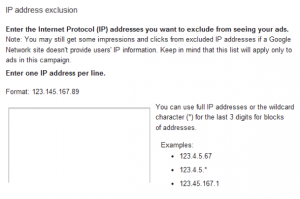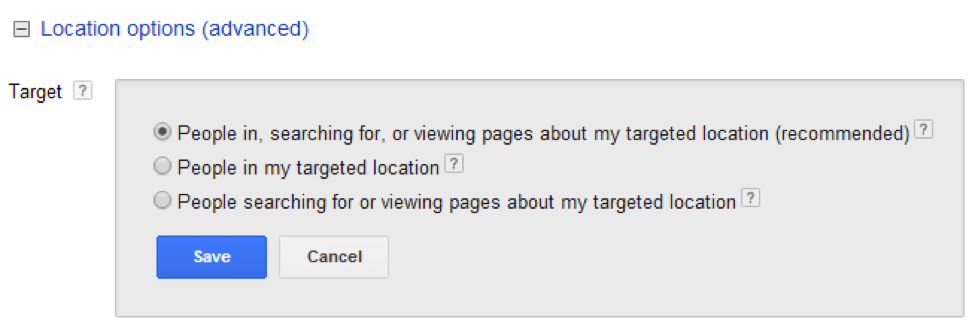Any digital marketing strategy—scientific or otherwise—would be incomplete, and most likely ineffective, without harnessing the power of Google AdWords. If you’ve read “A Beginner’s Guide to Google AdWords”, you know that AdWords will display your listing at the top or bottom of the result page in prime view of those searching for your product or service.
If you’re not familiar with AdWords, we suggest you read the beginner’s guide first, as we’ll be building on that information to investigate some advanced features of this essential tool. We also suggest reading the 3 Most Common SEO Mistakes Science Marketers Make, as that can inform your AdWords experience as well.
Advanced features
Adjust for geography, not location
As you can see above, the recommended/default location setting targets “People in, searching for, or viewing pages about my targeted location” (emphasis ours). Think about that for a moment. Let’s say you are a U.S.-based company marketing to scientists in the U.S. With the recommended setting, you’ll be paying for clicks from people searching for or viewing pages about your targeted location. That means your ad might wind up in front of someone in Kazakhstan or the United Arab Emirates—a far cry from the U.S.—because they searched for the right combination of keywords. With this option, your audience is the too wide geographically, and that’s usually not what you really want from your targeted marketing campaign.
Choosing the second option (“People in my targeted location”) on the other hand, will restrict your ad to only those in the U.S. (for example). You’ve now made use of geo-targeting and refined the search parameters down to a much smaller area (relatively speaking, of course) and improved the likelihood that your ad will wind up in front of your specific audience. That’s exactly what you want from your targeted marketing campaign. Ensuring that your ad winds up where it should leaves you free to craft the ad in a way that will motivate the scientific buyer.
Get suggestions direct from Google

These suggestions come in the form of Google’s Opportunities tab. What exactly is that and how does it work? Google explains:
“The Opportunities tab looks at your account’s performance history, your campaign settings, and Google search volume and trends, and automatically generates opportunities that could improve your performance.”
That’s good news for you because no one (no matter how much they claim to the contrary) knows as much about your metrics and how to interpret and improve them as Google. Opportunities can save you money (e.g., setting location bid adjustments) and improve your campaign’s effectiveness (e.g., achieving more clicks) at moving your audience through the marketing funnel.
Set Google Analytics goals and track them with AdWords
Again, no one (or no thing) knows more about your metrics than Google. So why not bring two of the most powerful tools in the digital marketing business together to improve your campaign?
Google Analytics allows you to set up your goals in the form of event tracking (a sale or a transaction in the image below) and then import them to AdWords where they can be further tracked using conversion tracking.

You can use these tools in tandem to track everything from pop-ups to lightboxes to newsletter signups, so don’t get caught without at least a passing knowledge of how your campaign is doing (and how to improve it). Put Analytics and AdWords to work together to make your scientific marketing shine.
Example: Setting Up AdWords Campaigns To Target Mass Spectroscopy
So let’s say you’re a U.S. company targeting U.S. scientists with an AdWords campaign for “mass spectrometry in crime scene investigation”. After you’ve set up all the basic information, it’s time to tweak the advanced settings for more power.
As we saw in the geo-targeting section, you want to set the advanced location option to target people in your targeted location (get as specific as you can here). This gets your campaign in front of the right audience and doesn’t display your ads in places where they’re not relevant.
Next, you should set up Google Analytics goals and import them for tracking in your AdWords campaign. This let’s you know what’s successful, and what’s not, while allowing you to tweak your campaign for maximum effectiveness. For example, you could set up Google Analytics to track how often a form is completed providing you with valuable conversion rate information.
Finally, and after you’ve got everything else adjusted, you’ll want to check out the Opportunities tab to find out what changes Google suggests to optimize your mass spectroscopy campaign. Accept or reject these suggestions as you see fit.
More Advanced Features
IP exclusions
This is done for the sole purpose of preventing your competitors from seeing your ads. Why would you want to do this?

For one thing, they could be clicking on your AdWords for no other reason than to cost you money. There’s obviously no chance that your competitors are going to convert to sales for your product or service so don’t put yourself in the position to be taken advantage of in this manner—block their IP address. To learn more about how to find the IP address of a competitor, we recommend talking to an IT professional at your company.
Scheduling
Picture this: It’s 2 a.m. You don’t open for another seven hours. So should you be running ads? If your product or service can be sold directly through a website, that’s one thing; the customer can buy any time she feels like it. But if your sales funnel involves person-to-person contact (as is more likely the case with a scientific marketing campaign), that person who found your ad at 2 a.m. is going to have to wait a full six or seven hours to receive a response. By that time, the interest has waned and the lead’s gone cold.
That’s where scheduling comes in. This feature allows you to schedule the time range that your campaign is visible. It can be especially useful, say, if your offices are located on the West Coast and you want to delay display on the East Coast until you’re open. Scheduling can also be used to great effect after using Analytics to determine when your target audience is most likely to click through.
Real-time updates
Google’s real-time update feature allows you to customize your ad as you see fit. Doesn’t sound like something you’d want to put to use? Consider this: “Ad customizers adapt your text ads to what someone is searching for, which device she’s using, where he’s located, or even the date, time of day, or day of the week. You can insert a price, the time left before a sale ends, and any other text that you define. For example, a line of text that says, ‘Hurry, sale ends in ___ days!’ can be filled in with the right number of days. All of that (and more) with only a few bits of code.
Take the example below (taken from the Google AdWords Help page):

All of the yellow-highlighted text can be changed dynamically (or automatically by Google based on your settings) to better attract the attention of your target audience.
Example: Setting Up AdWords Campaigns To Target ‘Chromatography’
Again, let’s say you’re a U.S.-based company targeting U.S. scientists with the keyword “chromatography for organic biomes”. After setting up the basics of the campaign, you tailor your ads (using real-time updates) to be specialized according to each search or webpage viewed. For example, you can add a time-sensitive call-to-action (“Free webinar in 2 days!”) that counts down until the date and time of the webinar. Then you scale the ad so that it has multiple variations that only display to the relevant audience.
After examining your metrics from other campaigns and determining when most of your traffic is occurring, you use the scheduling feature to customize your ads to appear at the prime time to drive traffic to and through your marketing funnel.
Finally, you can do a bit of sleuthing to find the IP address of your competitors and use the IP address exclusion feature to keep them from copying your brilliant marketing ideas.
Take AdWords for a spin today
It has never been easier to customize your scientific digital marketing campaign. With Google AdWords, you have a vast array of tools available that can refine and focus your ads to get the most return on your investment. Don’t let another day go by without at least investigating AdWords’ advanced features.
Have tips on AdWords for science marketers? Tell us about it below.



















